Community energy steps up: decarbonising at the local level
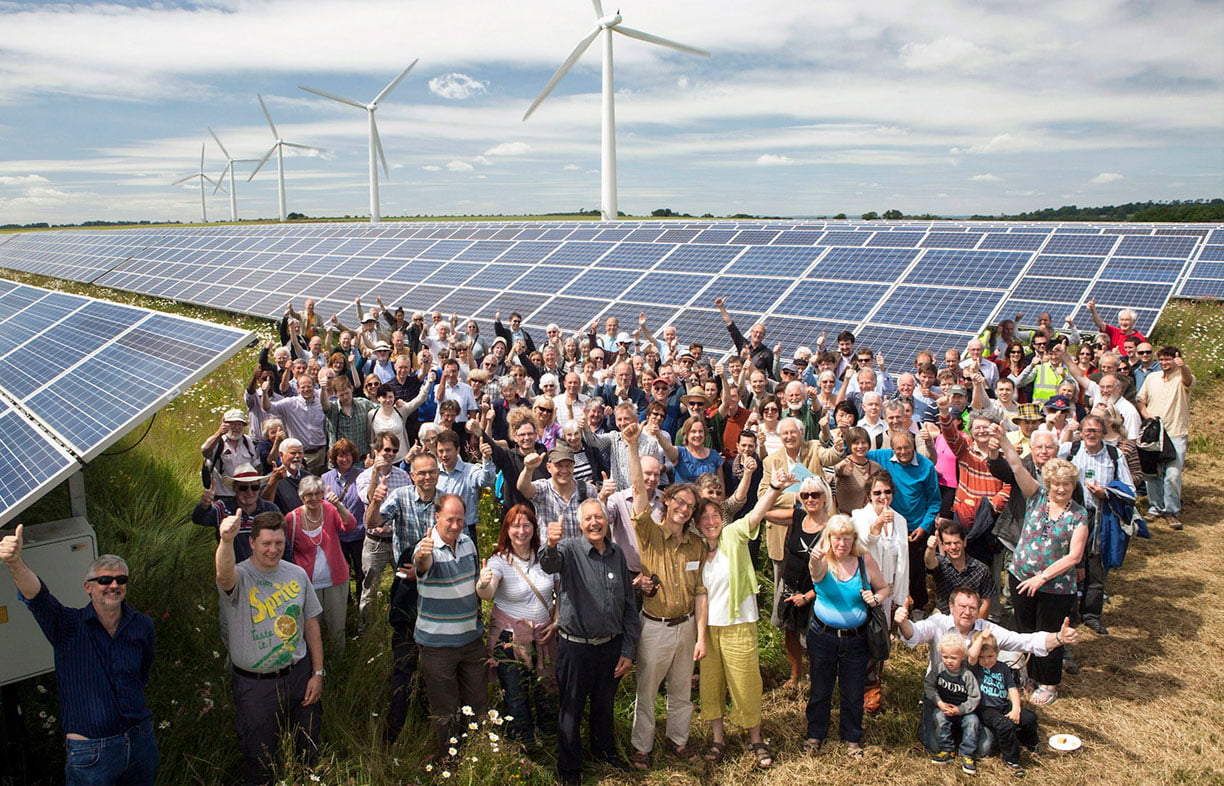
Community energy is growing fast! Jarra Hicks and Franziska Mey of Community Power Agency report on the many projects taking off and some of the remaining barriers under investigation.
This article was first published in Issue 136 (July-September 2016) of Renew magazine.
Since Australia’s first community-owned renewable energy project, Hepburn Wind, started generating in mid-2011, many projects have followed to create a small, but rapidly growing movement.
Integral to that growth has been the Coalition for Community Energy (C4CE), a loose coalition of organisations working to promote and foster community energy projects. C4CE reports that there are now 73 groups developing community energy of all different kinds across all states and territories in Australia—from solar and battery storage projects to replace diesel in remote communities in WA, to bioenergy projects using town and agricultural waste, to partnerships with larger wind and solar developers.In C4CE’s first assessment of community energy in Australia in 2015, groups reported on 23 operating projects, accounting for more than 9 MW of installed wind or solar capacity. Together they involve over 21,000 people and produce 50,000 MWh of electricity per year, avoiding 43,000 tonnes of carbon dioxide emissions. Since then, at least eight more projects have begun operating.
What’s driving community renewables?
The number one driver is that people care about climate change. A 2014 survey found that reducing carbon emissions to address climate change was the leading motivation for most groups (89%). In fact, almost half of all projects have grown out of climate action groups in communities. In a context where the effects of climate change are being felt more and more each year and our government continues to take a weak and changeable stance on climate policy, this is likely to keep driving communities to pursue their own local source of clean energy.
Also, we are starting to see links with the anti-coal and gas movements, as communities threatened with new fossil fuel developments want to pursue safer and less disruptive means of generating energy. This is especially the case in the Northern Rivers in NSW, where there has been an explosion of activity in the past four years, alongside a successful campaign to boot out coal seam gas.
But community energy is also about social benefits. In the same survey, the next most cited motivations were the more social aspects of ‘community self-sufficiency and resilience’ (80%) and ‘engagement and empowerment’ (74%). People involved really value the social-focused aspects—like making sure there are opportunities for community participation, ownership and benefit. People also value the local dimension—coming together with other people in their local area to collectively act on issues of concern. Interestingly, economic motivations (such as getting a return on your investment or generating income for the community) which have driven development in other countries (e.g. Scotland) were slightly less important to the surveyed groups (71%).
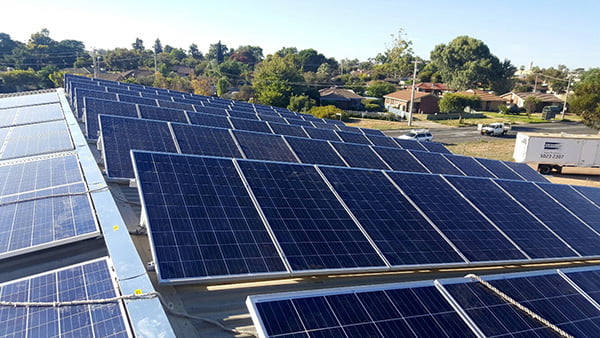
What’s holding community renewable energy back?
Let’s face it, the national electricity market wasn’t set up for small-scale distributed energy generation. However, although groups face a complex regulatory environment and a number of institutional barriers, they have found innovative ways to implement renewable energy projects and introduce new opportunities for energy generation in their communities. As small and unknown actors operating in an unstable renewable energy policy environment, it is often particularly challenging for community-owned projects to interact and negotiate beneficial arrangements with energy retailers, financiers and grid operators. One of the biggest challenges is being able to sell the electricity generated at a fair price. At present, the options are either to sell the electricity generated on the site where it is generated—aka ‘behind the meter’—or to sell it to an energy retailer.
Ideally, a project would be able to sell its electricity to its members or people in its neighbourhood, but this is currently not possible without first going through the arduous and expensive process of becoming your own energy retailer (not recommended). Two exciting developments that could help change this are the new citizen-owned energy retailer, Enova, and various trials of ‘local electricity trading’, such as those in Byron Shire and Willoughby (see “LET’s trade electricity with our neighbours” at end).
What’s really working?
Solar, solar, solar! Community solar is really kicking some goals and two main models work effectively in the current Australian context. In response to the challenges mentioned above, both models involve a so-called ‘behind the meter, below the load’ approach, where a host building (a large energy user) agrees to purchase all the electricity produced from a solar PV array installed on their roof by the community group. This avoids the issue of selling the energy into the energy market. The two main models for delivering ‘behind the meter’ solar are donation-based and investment-based.
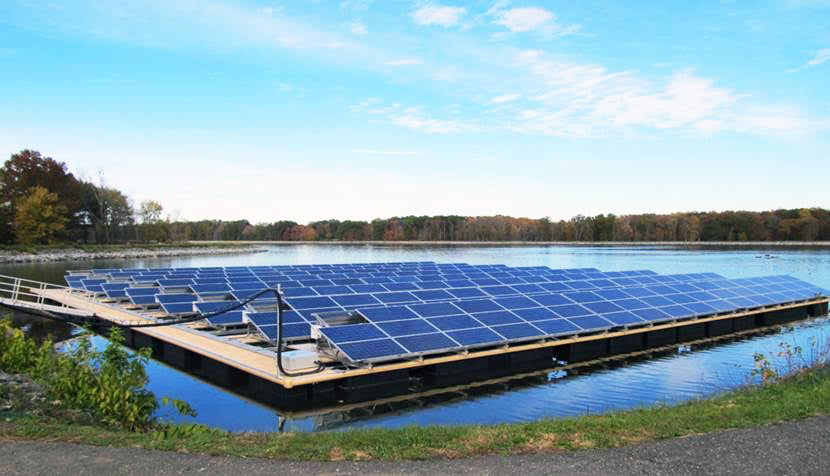
1. Donation-based
The Citizens Own Renewable Energy Network Australia (CORENA) started operating in 2013 and has already completed 12 solar PV projects ranging in size from 3 to 10 kW. CORENA uses donations from the community to build up a revolving fund mechanism. They offer interest-free loans to non-profit community organisations in all parts of Australia to install solar on their roof combined with energy efficiency measures. As of April 2016, more than $120,000 had been donated by CORENA’s supporters, enabling the installation of 12 solar projects with a total capacity of 74 kW. The not-for-profit beneficiary of the solar repays the loan and the money goes back into the revolving fund. The main goal of CORENA’s ‘Quick Win Projects’ is for them to become self-funding. Eventually, a (donated) funding pool of $210,000 will enable one new community solar project every three months; $630,000 would fund one new project every month, forever.
Repower Shoalhaven started with similar goals but on a somewhat different path. Headed by a dedicated social entrepreneur and economist, Repower Shoalhaven Association aimed to set up clean energy investment opportunities for their local community. One reason for their success was the decision to start small and to keep the momentum by starting with a simpler and easier to deliver donation-based project. Donations from the local community funded a 9 kW solar PV array for the Kangaroo Valley Community Centre and Ambulance Station, just a year after the organisation kicked-off.
2. Investment-based
The next big step for Repower Shoalhaven was to develop an investment project: Repower One. It was financed through raising $120,000 in a community share offer to install and own 80% of a 99 kW PV array on the rooftop of the Bowling and Recreation Club in Shoalhaven Heads in October 2014. The club agreed to purchase all electricity produced for an agreed price with the income received repaid to investors as a dividend. The project was met with great enthusiasm and the next project followed just nine months later, with Repower Two comprising two 15 kW solar systems installed on the roof of two local churches. Since then, the organisation has been busily signing up new host sites, with at least three new projects in the pipeline.
Clear Sky Solar is another successful model with nine projects and a total capacity of 425 kW up and running as of March 2016. This community group emerged as a local chapter of the Clean Energy for Eternity Association, established during the height of the climate movement in 2006. In their model, community investors form a trust which then provides a loan to a solar company that owns and operates the solar PV installation on behalf of the host site (e.g. the Boggabri Pub).
A final example, the partnership between the City of Lismore and Farming the Sun Inc, demonstrates the great potential for local council and community collaboration. Lismore City Council and Farming the Sun have now completed negotiations to build two solar farms, one at the Goonellabah Sports and Aquatic Centre and the other at the East Lismore Sewage Treatment Plant. To overcome limitations at the East Lismore site, a truly innovative solution with a floating solar system was found. Community investment will provide a loan to fund the construction of the solar farms; the farms will be owned by the council and will use all electricity generated on-site.
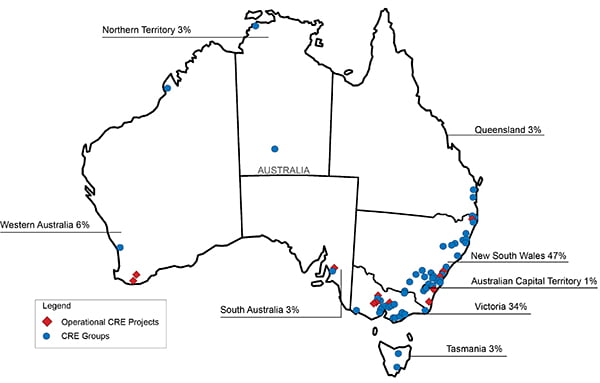
A bit more on the forms community renewable projects take
As noted, community renewable projects use models that are either donation or investment based, where individuals in the community put money (and effort!) in to make the project happen. They invariably rely on a large amount of voluntary work (both to get them up and keep them running) and often get some grants in the early stages to help them on their way. Large grants were important for getting both Hepburn Wind and Denmark Community Wind (the two existing community wind energy projects) up and running due to the large upfront cost of the many feasibility studies and the planning applications, both of which can take years. Solar PV is proving to be a much more straightforward, scalable and flexible technology for community groups to work with. For this reason, a majority of groups are pursuing solar PV in various forms.
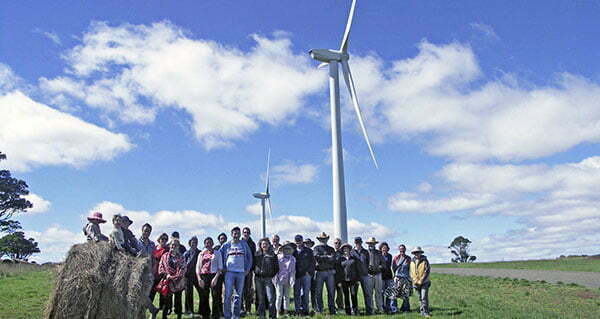
Because a community energy project requires balancing the desire for community ownership with the realities of policy, regulation and financial practicalities, getting the legal structure right is essential. Incorporated associations are often used for donation-based models, whereas cooperatives are favoured for investment-based models. The majority of groups are choosing to employ company structures because they are more commonly used and are better understood by lawyers, potential investors and regulators. But some groups are changing their company constitutions to still be able to have cooperative-style democratic voting rights or place restrictions on shareholdings, for example, requiring people to be local or putting limits on maximum investments, so that groups can still achieve broad local participation.
The financial structures demonstrate commitment to ‘purpose over profit’, broad community benefit and the value of volunteering. Of the 35 groups surveyed in 2014, a quarter were for-profit and the rest were not-for-profit. The for-profit projects expect to offer, or are already offering, community investors a return on their investment. In several cases, this is done alongside contributing to a community fund in order to ensure the financial benefits of the project are also distributed to the broader community. For example, Hepburn Wind contributes $30,000 per year ($7500/MW/year) and Denmark Community Windfarm contributes $10,000 per year ($7100/MW/year) to purpose-built grant funds. In some cases, community fund contributions are prioritised before returns to investor-members, reflecting a strong commitment to sharing the benefits within the community, not just with the shareholders.
However, this is only currently offered by the two established megawatt-scale wind farms, rather than the much smaller, and financially more marginal, community solar projects. However, of the 25 or so not-for-profit groups, five are using the profits generated to establish a revolving fund to go towards future community solar projects.
What does it all add up to?
People plus power is powerful! From the experience of countries such as Germany and Denmark, we know that community-owned renewable energy has the potential to play a driving role in building a movement for a renewable energy transition. In both these countries, community projects have led investment in and installation of renewable energy, and have created a strong base of political support for policies that will push a renewable energy transition at a national level. Although it is premature to know just what the impact might be in Australia, some indications of the change potential can be gleaned from the increasing political support from state governments (ACT Government 2015, NSW Government 2015, Victorian Government 2015), local government (City of Sydney, Lismore City, Byron Bay), political parties (Australian Labor 2015, The Greens Australia 2016) and larger NGOs (e.g. GetUp). These changes are helping projects to progress, with the clear benefits of renewable energy and carbon emissions reductions, as well as advancing community ownership, participation and benefit.
LET’s trade electricity with our neighbours

There has been a buzz around virtual net metering (or local electricity trading—LET) in the community energy scene. The concept promises to open up great potential to distribute and sell electricity locally (without being an energy retail company) and hence unlock substantial opportunities for community renewable energy. A local electricity trading arrangement would allow the generation at one site to be ‘sold’ or assigned to the bill of a nearby site on a time-of-use basis.
In effect, this would allow a community energy generator to provide its electricity to nearby collaborators, increasing the value for its electricity by selling at closer to retail rather than wholesale rates. While this opportunity has contributed to the great success of a community solar program in the USA known as Solar Gardens, it is still largely untested in Australia.
Since June 2015 the Institute of Sustainable Futures has led a consortium of 12 private and public partners (including councils, network and retail energy companies and not-for-profit organisations) to investigate the viability of LET in five virtual trials across eastern Australia. This includes a trial with Moira and Swan Hill shire councils of a community-owned solar farm selling energy to its members.
The project also examines the introduction of local network credits for local generators being used in the local area—reflecting that they are using just part of the electricity network, resulting in lower long-term costs of grid supply in the upstream parts of the network. Both concepts—LET and local network credits—address some of the main regulatory barriers to community renewable energy. Already the preliminary results of the ISF trials show that introducing these arrangements in Australia can contribute to more efficient investment and operational decision-making for community energy projects and electricity grid users more generally.
These investigations came just in time to inform public consultation on a proposal to establish local generation network credits being considered by the Australian Energy Market Commission. Vocal support for careful consideration of the rule change will be crucial in securing a positive outcome.Find out more about the ISF project at www.bit.ly/1TQCTRg, about Solar Gardens at www.bit.ly/20oEBOj and about the rule change here: www.aemc.gov.au/Rule-Changes/Local-Generation-Network-Credits.
This article was first published in Issue 136 (July-September 2016) of Renew magazine. Issue 136 has water saving as its focus.
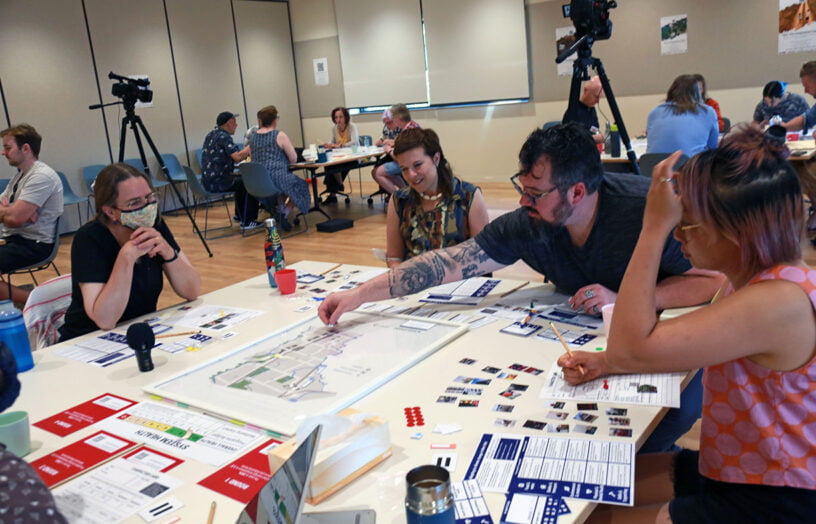 Community
Community
Game of life
The Adaptation Game is a new interactive board game that uses science and storytelling to simulate how you and your community can respond to the next 10 years of climate change.
Read more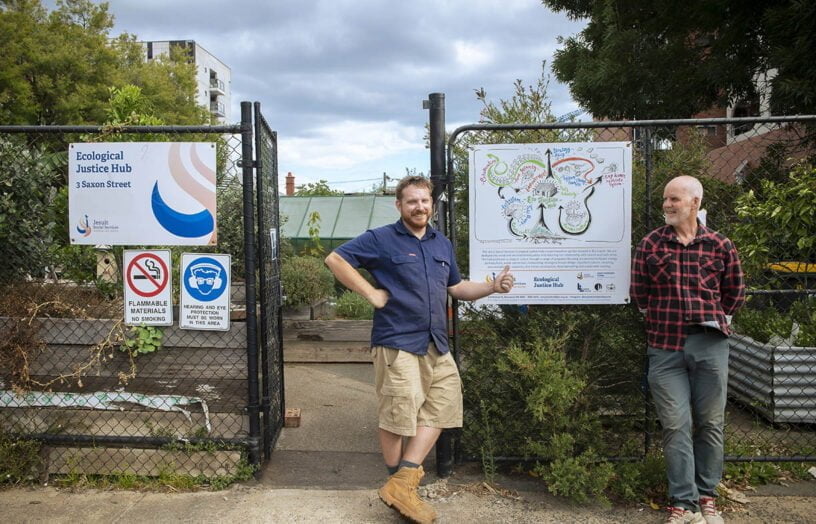 Reuse & recycling
Reuse & recycling
Community eco hub
Nathan Scolaro spends 15 minutes with Stuart Wilson and Michael McGarvie from the Ecological Justice Hub in Brunswick, Melbourne.
Read more Renewable grid
Renewable grid
Is a floating solar boom about to begin?
Rob McCann investigates the world of floating solar energy systems.
Read more
